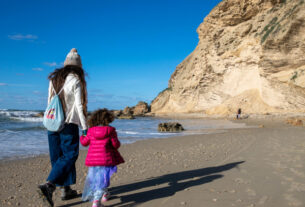Many of my readers know I devote a fair amount of my professional time to trauma work, as I am quite concerned about its psychological impact on both adults and children. Between terrorism, Iranian threats, long power outages, civic discord, and being in an earthquake zone, I sometimes think that as a country, we are a study in coping. And for the most part, we do it very well. We hear about a disaster, check up on our loved ones, and move on. We live for the moment and make the most out of life. And most importantly, we know just how precious life is.
We can be super proud of our recent response to the earthquakes in Turkey, and now we must make sure that we are as prepared as we can be here at home. In our busy lives, and being overwhelmed with seemingly one thing after another, it is easy to ignore what does not seem emergent; but good planning and organization are essential and instill calm for us and our families.
Think back to the fire drills that you had when you were a child. While most people never have had to put the experience to good use, we knew that should anything happen, our rehearsal helped us know just what to do.
Disasters generate sudden, unexpected, intense anxiety. In general, people fear being hurt, being separated from their loved ones, and being left alone. They prefer a sense of control to helplessness. Knowing what must be done without panic and without having to think is the key to emergency response. It is precisely this that we can easily teach our children. Creating a comprehensive “family individual emergency response” (FIER) plan can reduce everyone’s anxiety and sense of helplessness, increase self-confidence and provide peace of mind. If you can remain calm and feel less vulnerable, then others around you will do better.
To help you generate your own FIER, you’ll want to ask questions in anticipation of any hypothetical emergency. This will help you best prepare and protect yourself and your loved ones, physically and emotionally, in a disaster.
Here are some basic suggestions to consider in your FIER plan:
- Determine safe meeting places for your family. Define a designated meeting place within your house, one immediately outside of your house (such as by a certain tree or on the front lawn of a neighbor’s home), and then a spot that is a short walking distance from home (perhaps near a school). If you were for some reason separated from your children, could they use this easy location to meet up with the rest of the family at a later time? If, for example, there was an earthquake and you were not home but the children were, where could they safely go and what should they do? If they were outside, what are the safest options? Brainstorm together.
- Have lots of drills. Define what job each family member should have and practice through play-acting what an emergency might feel like and where each person could safely go. Each child could take on an age-appropriate task and should know the drill routine and FIER plan well. Children have great observation skills and can serve as the eyes and ears to ensure that all is okay within their own environment. Teach them what to look for.
- Keep emergency numbers handy. If children carry cell phones, make sure that they have emergency phone numbers, which also include the numbers of a close neighbor or friend. Keep this list posted in an accessible place at home, as well as in the child’s belongings. Even a well-known number or address can be forgotten in times of stress. Discuss too a third party with whom your child can check in if you are not available. Children need to know that in an emergency, phone lines may be down and cellphones not operational. They may need instead to contact a neighbor, if safety permits, by foot.
- KEEP APPROPRIATE emergency supplies on hand for home or when traveling. These include water, some non-perishable foods, flashlights, a radio, a whistle, blanket, small fan, first-aid kit, pencils and paper. Make sure everyone knows where these things are and what they’re used for.
- Teach the entire family how to act calmly. Use calming and silly imagery, along with healthy breathing techniques, and share these scenes with each other. Practice positive thinking and positive self-talk. These benefit everyone. Statements such as “I am doing okay” or “I can do it” are very empowering. Pair young children with older family members and practice talking slowly and quietly while using a “calm voice” and “calm breathing.”
- Listen to your family’s concerns. What is each member of the family thinking? Sometimes just reassuring them that it is your job to always try to take care of them will be all they need to feel secure. Children will look to you for information. Be aware too of what children watch on television. Some shows may increase your child’s anxiety. Screen their access to media, as children do not benefit from traumatic events being replayed again and again. Turn off the television.
- Talk about your feelings. Share your thoughts and feelings with a supportive family member, friend or therapist. Sometimes we assume that children are unaware of the current issues and in trying to protect them, we inadvertently shield them from information and fail to talk with them about how they can best cope in an emergency. Sadly, they may think that the topic is unsafe for discussion and then may imagine the worst. Your silence may inadvertently reinforce their fears. Talking about fears and keeping children informed about what is happening reduces anxiety.
- Give children age-appropriate information. Tell children what you feel they need to know in a simple and open manner. Be honest about what you know and don’t know, and give them information that they can understand. Find a way to present information positively. Usually, less information is better. Let children know that they can always ask questions and that as an adult, you will attempt to answer them. This will enhance their coping skills and reduce their stress. Most children, through media access or school, have at least some information, although it may not be entirely accurate.
- Talk about stress in general. Let children know that there are many signs of stress and anxiety, varying from rapid breathing, a fast heartbeat, feeling dizzy, confused, weak, sad or feeling frightened. These are normal responses to an abnormal situation, and everyone experiences them. The more we know and the more prepared we are, the more we feel in control and know what to do. If we are prepared and have practiced ahead of time what we have to do, it makes it much easier to cope when there is an emergency. Children can rehearse, role play, get stickers or other rewards and feel proud of being an “emergency responder.”
Remember, it never hurts to be prepared.
This column is based on Chapter 63, “Terrorism: Let’s Talk About It,” in the writer’s book Life’s Journey: Exploring Relationships – Resolving Conflicts.
The writer is a licensed clinical psychologist in private practice in Ra’anana, who has written about psychology in The Jerusalem Post since 2000. [email protected]; www.drbatyaludman.com




